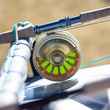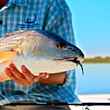My 19-year-old daughter had driven over from her summer gig in the Tetons to chase some native cutthroats with me at our favorite little haunt high in the Caribou Range of eastern Idaho, and the fish were cooperating.
Delaney was using her tenkara rod—she can cast a traditional fly rod, but the tenkara rod is her favorite. It’s simple, packable and generally fool-proof, especially on small water where fly line has a knack for finding overhanging willows and getting caught on rocks and snags at your feet.
She and I had spotted a sizeable cutty holding and sipping crippled caddis under the shade of streamside willows about 30 feet upstream, and if she was going to make the cast to that fish, she’d have to move her feet first. She’s a pretty intuitive angler, but she still asks questions, which is a good thing. But the tenkara rod limited her distance, and she showed surprising grace navigating the creek’s slippery rocks on her way to a reasonable casting position in a pair of old sandals.
Oh, to be young again.
Set up slightly downstream and across from the working cutthroat—and still unnoticed by the fish, judging from its regular rises beneath the willows—she knew she’d have to make a solid cast to get a look. With her 13-foot-long tenkara rod, she started false casting a size 14 brown caddis, a reasonable imitation of the bugs that were climbing out of the creek and occupying the streamside vegetation. They were everywhere, and the cutthroats were into them.
Her first cast was spot-on, and the drift, using the long, supple rod, was ideal. But it didn’t get a look. After the fly drifted through the sweet spot, she lightly lifted the line off the water and recast. This effort was short of the target by about two feet, but I figured it would at least get a solid drift.
She went to pick up the line, but I interjected.
“Leave it,” I said. “Just let it drift. You don’t want to spook the fish.”
Especially when fishing dry flies, it can be crucial to let an errant cast drift through your target water even when it’s a little (or a lot) off the mark. Frustration can often tempt us to rip a cast that lands far shy of its target off the water for a prompt recast, but doing so can easily and often put down not just the individual fish you may have been targeting—but any others that may be lurking beneath the surface as well. When that happens, it won’t matter how good your next cast is.
She lowered the rod tip and let the caddis drift. We both watched as the big cutthroat left the shadows of the overhanging brush and charged after the dry fly. She connected and moments later, she showed off her catch.
The lesson? Sometimes fly fishing can be just like horseshoes or hand grenades. It doesn’t always have to be perfect … it just has to be close. Fishing a bad cast through the drift can sometimes result in surprising results. Often, I’ve had short casts or long casts result in solid hook-ups, and sometimes with fish I wasn’t even targeting.
Certainly, casting accurately is an important skill to possess and hone over time. But in many instances, casts gone awry can work in an angler’s favor.
Last spring, while chasing bonefish in Chetumal Bay, our guide, Nato, put my fishing buddy Rachel on bonefish after bonefish, just by simply telling her when to cast and generally where. His favorite words of advice to the novice saltwater angler? “Leave it.”
“Half the time, I had no idea what I was doing,” Rachel told me at the end of that epic day. “Nato would tell me to cast, and I’d just cast. I didn’t start seeing the fish until the end of day.”
To be clear, Rachel’s cast weren’t bad casts. But they were simple casts to the general location where Nato knew the fish would eventually be—sometimes she was 20 feet away from her intended location, but Nato knew enough about the fishing moving down the shoreline to know that, even though the cast was not ideal, the fish would eventually move closer to the resting Gotcha sitting in foot-deep water, and at the right time, a little action would cause a bonefish to move away from the school and investigate.
When the fish got closer, Nato would coach Rachel again. “Strip. Strip. Set!” And Rachel would land yet another bonefish.
It was simply a matter of getting close.
This lesson was burned on my brain during my first guided trip, many years ago, to the Henry’s Fork through what’s known locally as Cardiac Canyon. Our guide was a seasoned veteran—a great guy who worked really hard to get quality drifts through deep water.
Errant casts from both me and my fishing partner where usually greeted with the same advice that Nato delivered to Rachel.
“Leave it,” the guide would say. “Fish it through.”
And, of course, not every crappy cast resulted in a hookup, but enough did to make both anglers in the cataraft fish nearly every cast through its entire drift. My fishing partner for the day landed a 22-inch in rainbow on a cast that nearly took the guide’s head off on the backcast. It landed well short of the intended run, but a hungry trout has no idea who’s on the rod when a fly somehow drifts right through its sweet spot.
It’s a good lesson to learn. Fish almost every cast you make. Every time.





























Comments
Glenn Dotter replied on Permalink
Chris is absolutely right. A fly on the water stands a far better chance of catching a fish than a fly in the air. Fish the drift even if you think it was a lousy cast. The fish will tell you if it was a good cast. They are the judge, the jury, and the executioner. Sometimes that's "perfect" cast wasnt so "perfect".
Way to go Chris!
Tom Panek replied on Permalink
I tried to get a friend of mine to understand this one day. He wasn't having much luck, so I put him on a small bucket that consistently produes two or three trout. I advised him no matter where his cast landed to just leave it. "Fish the cast," I told him, whcih is one of my axioms. He didn't get it. Afet a near miss, and an aborted attempt to put a cast in exactly the same spot, he ripped the fly off the water, despite my telling him to leave it. A third bad cast put all the fish down, and he was done.
Fish the cast. Even if it's far off the mark, a trout will cross the run to get a meal. And if it doesn't, you still get another chance. Let your fly float out of the zone before you pick it up.
Pages